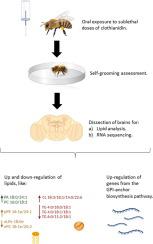Journal of Advanced Research ( IF 11.4 ) Pub Date : 2021-08-13 , DOI: 10.1016/j.jare.2021.08.007 Nuria Morfin 1 , Tiffany A Fillier 2 , Thu Huong Pham 2 , Paul H Goodwin 1 , Raymond H Thomas 2 , Ernesto Guzman-Novoa 1

|
Introduction
Honey bees (Apis mellifera) play key roles in food production performing complex behaviors, like self-grooming to remove parasites. However, the lipids of their central nervous system have not been examined, even though they likely play a crucial role in the performance of cognitive process to perform intricate behaviors. Lipidomics has greatly advanced our understanding of neuropathologies in mammals and could provide the same for honey bees.
Objectives
The objectives of this study were to characterize the brain lipidome of adult honey bees and to assess the effect of clothianidin (a neurotoxic insecticide) on the brain lipid composition, gene expression, and performance of self-grooming behavior under controlled conditions (cage experiments).
Methods
After seven days of exposure to oral sublethal doses of clothianidin, the bees were assessed for self-grooming behavior; their brains were dissected to analyze the lipidome using an untargeted lipidomics approach and to perform a high throughput RNAseq analysis.
Results
Compared to all other organisms, healthy bee brain lipidomes contain unusually high levels of alkyl-ether linked (plasmanyl) phospholipids (51.42%) and low levels of plasmalogens (plasmenyl phospholipids; 3.46%). This could make it more susceptible to the effects of toxins in the environment. A positive correlation between CL 18:3/18:1/14:0/22:6, TG 6:0/11:2/18:1, LPE 18:0e and intense self-grooming was found. Sublethal doses of a neonicotinoid altered PC 20:3e/15:0, PC 16:0/18:3, PA 18:0/24:1, and TG 18:1/18:1/18/1 levels, and affected gene expression linked to GPI-anchor biosynthesis pathway and energy metabolism that may be partially responsible for the altered lipid composition.
Conclusion
This study showed that lipidomics can reveal honey bee neuropathologies associated with reduced grooming behavior due to sublethal neonicotinoid exposure. The ease of use, unusual brain lipidome as well as characterized behaviors that are affected by the environment make honey bees a promising model organism for studying the neurolipidome and associations with neurobehavioral disorders.
中文翻译:

对蜜蜂(Apis mellifera)脑脂质组及其新烟碱诱导的与自我梳理行为减少相关的改变的首次见解
介绍
蜜蜂(Apis mellifera)在食品生产中发挥着关键作用,它们表现出复杂的行为,例如自我梳理以去除寄生虫。然而,他们的中枢神经系统的脂质尚未经过检查,尽管它们可能在执行复杂行为的认知过程中发挥关键作用。脂质组学极大地促进了我们对哺乳动物神经病理学的理解,并且可以为蜜蜂提供同样的信息。
目标
本研究的目的是表征成年蜜蜂的大脑脂质组,并评估噻虫胺(一种神经毒性杀虫剂)在受控条件下对大脑脂质组成、基因表达和自我梳理行为表现的影响(笼子实验) .
方法
在暴露于口服亚致死剂量噻虫胺 7 天后,评估蜜蜂的自我梳理行为;他们的大脑被解剖以使用非靶向脂质组学方法分析脂质组,并进行高通量 RNAseq 分析。
结果
与所有其他生物体相比,健康的蜂脑脂质组含有异常高水平的烷基醚连接(质浆基)磷脂(51.42%)和低水平的缩醛磷脂(质浆基磷脂;3.46%)。这可能使其更容易受到环境中毒素的影响。发现 CL 18:3/18:1/14:0/22:6、TG 6:0/11:2/18:1、LPE 18:0e 与强烈的自我修饰之间存在正相关关系。亚致死剂量的新烟碱改变了 PC 20:3e/15:0、PC 16:0/18:3、PA 18:0/24:1 和 TG 18:1/18:1/18/1 水平,并受到影响与 GPI 锚定生物合成途径和能量代谢相关的基因表达可能是导致脂质组成改变的部分原因。
结论
这项研究表明,脂质组学可以揭示与亚致死性新烟碱暴露导致的梳理行为减少相关的蜜蜂神经病理学。易于使用、不寻常的脑脂质组以及受环境影响的特征性行为使蜜蜂成为研究神经脂质组及其与神经行为障碍的关联的有前途的模型生物。











































 京公网安备 11010802027423号
京公网安备 11010802027423号